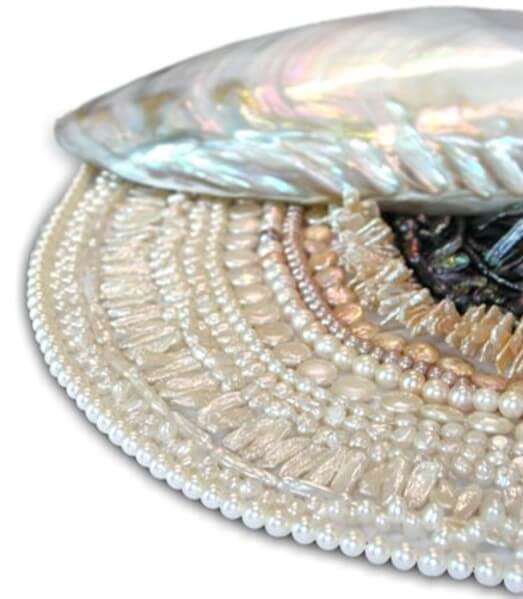In the intricate world of jewellery design and artistry, pearls stand out as symbols of elegance and sophistication. Understanding the various types of pearls, including keshi, conk, and Melo Melo, and their distinct characteristics is important for designers aiming to infuse authenticity and innovation into their creations. This article delves deep into the realm of pearls, offering insights into their culturing process, historical significance, and methods for distinguishing between natural, cultured, and imitation pearls. For jewellery designers and artists seeking to elevate their craft and knowledge, mastering the art of pearl identification is not just beneficial—it’s essential.
Popular Pearl Varieties
Today, besides the main categories of freshwater and seawater pearls, there are several other types. I will mention some that are becoming more popular. Keshi pearls are typically a byproduct of pearl culturing. Keshi is a Japanese word meaning “poppy seed.” They form when the oyster rejects and expels the artificially implanted nucleus. The oyster then secretes nacre around the remaining piece of mantle tissue, creating a small, nucleus-free pearl.
The term “keshi” was also used for larger sizes because in saltwater and South Sea varieties, the nucleus may sometimes be rejected after insertion along with the mantle tissue. If the oyster rejects the nucleus, it could die. But if it survives and retains the mantle tissue, it can still produce a pearl using that tissue. Those pearls tend to be somewhat larger, but they are still known as keshi because they result from the culturing process.
Imitation Pearls

I would also like to discuss imitation pearls briefly. Imitation pearls date back to ancient times, as even the Egyptians were producing glass pearls around 300 BC. However, mass production of imitation pearls only started in the 16th and 17th centuries using glass, ceramics, and later, plastic. Some imitations were very convincing. Today people often inherit imitation pearls from their grandmothers or great-grandmothers that can be difficult to identify as such.
Rare and Unique Pearl Types
Lastly, I want to talk about two very rare pearl types prized by collectors: conch and melo melo pearls. Conch pearls come from the queen conch mollusc in the Caribbean Sea, which has a beautiful shell but is now an endangered species. Usually, only one in about 10,000 queen conchs produces a pearl. Truly exceptional conch pearls that are large, beautiful, and round are extremely rare and valuable. Queen conchs are fished and used as a food delicacy, so they are not specifically hunted just for their pearls.
Melo melo pearls originate in Asia and are typically a beautiful orange, yellow, or white hue. Like conch pearls, melo melo pearls are also very rare and natural. Both conch and melo melo pearls form closer to the mollusc’s digestive system rather than deep in the reproductive organs, which is more typical for cultured pearls.
Identifying and Testing Pearls
There are a few methods for identifying and testing the authenticity of pearls. Since high-quality imitations can be convincing, it can be difficult to distinguish real from fake. Comparing natural and cultured real pearls is even harder because their outer nacre coatings are identical. One definitive technique is x-ray imaging at a gemmological laboratory, which reveals differences in internal structure between cultured and natural pearls. Of course, cutting a pearl in half to inspect it would destroy even a natural one, so this should never be attempted.
A simpler approach is the tooth test. You gently rub the pearl across your teeth to feel its surface texture. If it feels gritty like fine sandpaper, it is likely natural or cultured. If extremely smooth like glass, it is probably an imitation plastic, glass, or ceramic fake. The tooth test has been used for many years without damaging real pearls.
Conclusion
I hope these insights help introduce the wealth of knowledge and inspiration available to jewellery designers and artists through the world of pearls. Understanding the culture and identification of various pearl types adds authenticity and creativity to new designs. By embracing this learning, artists can push the boundaries of artistry and create pieces that resonate with the beauty and rarity of these organic gems.
If you want to find out more and really explore the world of jewellery in more detail, we have a fantastic course called Gem and Jewellery Trade Secrets. It is a comprehensive course that will let you take control over your purchases if you’re a buyer or collector, or if you’re a designer or maker, it’ll help you better understand the gemstones that you’re going to be using in your jewellery.
The program is taught by me, Tanja Sadow, and it is one of our most popular hands-on programs because you’re actually getting a chance to look at and handle over 1,800 gem and jewellery exhibits throughout the program (for the physical classes in Singapore) . If you can’t make it to Singapore for the hands-on portion, you can also join in the online self-paced programme from anywhere in the world!
Tanja M. Sadow G.J.G.
Dean and founder of the Jewellery Design and Management International School

















